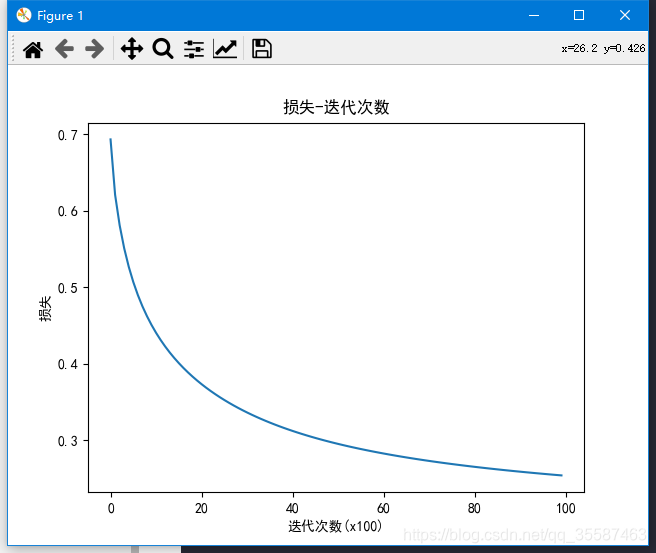import pandas as pd
import numpy as np
from matplotlib import pyplot as plt
from sklearn.model_selection import train_test_split
def init():
df = pd.read_csv("./breast-cancer.csv")
df = df.drop("id",1)
df = df.drop("Unnamed: 32",1)
df['diagnosis'] = df['diagnosis'].map({
'M': 1,
'B': 0
})
train, test = train_test_split(df, test_size = 0.3, random_state=1)
train_x = train.loc[:, 'radius_mean': 'fractal_dimension_worst']
train_y = train.loc[:, ['diagnosis']]
test_x = test.loc[:, 'radius_mean': 'fractal_dimension_worst']
test_y = test.loc[:, ['diagnosis']]
train_x = np.asarray(train_x)
train_y = np.asarray(train_y)
test_x = np.asarray(test_x)
test_y = np.asarray(test_y)
d = model(train_x.T, train_y.T, num_of_iterations=10000, alpha=0.000001)
costs = d ["costs"]
w = d["w"]
b = d["b"]
plt.plot(costs)
plt.title("损失-迭代次数")
plt.xlabel("迭代次数(x100)")
plt.ylabel("损失")
Y_prediction_train = predict(train_x.T, w, b)
Y_prediction_test = predict(test_x.T, w, b)
print("\n训练数据测试精确度: {}%".format(100 - np.mean(np.abs(Y_prediction_train - train_y.T)) * 100))
print("\n测试数据测试精确度: {}%".format(100 - np.mean(np.abs(Y_prediction_test - test_y.T)) * 100))
plt.show()
def initialize(m):
w = np.zeros((m,1))
b = 0
return w , b
def sigmoid(X):
return 1/(1 + np.exp(- X))
def propogate(X, Y, w, b):
m = X.shape[1]
Z = np.dot(w.T, X) + b;
A = sigmoid(Z)
cost= -(1/m) * np.sum(Y * np.log(A) + (1-Y) * np.log(1-A))
dw = (1/m)* np.dot(X, (A-Y).T)
db = (1/m)* np.sum(A-Y)
grads= {"dw": dw, "db": db}
return grads, cost
def optimize(X, Y, w, b, num_of_iterations, alpha):
costs=[]
for i in range(num_of_iterations):
grads, cost = propogate(X, Y, w, b)
dw = grads["dw"]
db = grads["db"]
w = w - alpha * dw
b = b - alpha * db
if i % 100 == 0:
costs.append(cost)
print("<%i>次迭代后的损失度: %f" % (i, cost))
parameters = {
"w": w,
"b": b
}
grads = {
"dw": dw,
"db": db
}
return parameters, grads, costs
def predict(X, w, b):
m = X.shape[1]
y_prediction = np.zeros((1,m))
w = w.reshape(X.shape[0], 1)
A=sigmoid(np.dot(w.T, X)+b)
for i in range(A.shape[1]):
if(A[0,i] < 0.5):
y_prediction[0,i] = 0
else:
y_prediction[0,i] = 1
return y_prediction
def model(Xtrain, Ytrain, num_of_iterations, alpha):
dim = Xtrain.shape[0]
w,b = initialize(dim)
parameters, grads, costs = optimize(Xtrain, Ytrain, w, b, num_of_iterations, alpha)
w = parameters["w"]
b = parameters["b"]
d = {
"w": w,
"b": b,
"costs": costs
}
return d
if __name__ == "__main__":
init()























 1814
1814











 被折叠的 条评论
为什么被折叠?
被折叠的 条评论
为什么被折叠?








